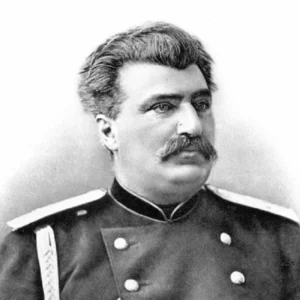Nikolay Przhevalsky was a Russian explorer who greatly aided European understanding of Central Asia. Despite his failure to reach his ultimate target, Tibet’s holy capital of Lhasa, he was successful in exploring numerous sites in Northern Tibet, including several places previously unknown to the Western world. He substantially extended the geographic knowledge of east-central Asia in European countries by his precisely documented route surveys and enormous plant and animal collections. He was born into a noble family in the Russian Empire and went on to the St. Petersburg Military Academy before becoming a geography teacher at the Warsaw Military School. He was so passionate about geography that he gave public lectures on the history of geographical discoveries.
Childhood and Adolescence
Nikolay Mikhaylovich Przhevalsky was born on April 12, 1839, into a noble polonized Belarusian family in Kimborovo, Smolensk Governorate, Russian Empire.
From 1849 to 1855, he attended the gymnasium in Smolensk, and from 1861 to 1863, he attended the General Staff Academy in St. Petersburg. ‘Voeimo-statistkheskoe ohozrenie Priamurskogo kraya’ (“A Military-Statistical Survey of the Amur Region,” 1862) was his graduation thesis.
In 1864, he was commissioned a lieutenant and employed as a teacher at the Warsaw Military School, where he taught history and geography, following his graduation. He also conducted public talks on the history of geographical discoveries and wrote a comprehensive geography textbook during this time (1867).
He had a strong desire to travel and requested that the Russian Geographical Society send him to Irkutsk, in middle Siberia. On the Russian-Chinese border, he planned to study the Ussuri River valley, a major tributary of the Amur.
This would be his first major journey, and he prepared by studying Humboldt’s and Karl Ritter’s writings on Asia, as well as gaining a thorough understanding of plants and avian taxidermy. From 1867 to 1869, the mission lasted two years. When he returned, he wrote a book called ‘Travels in the Ussuri Region, 1867-1869.’
In his notes, he wrote a detailed account of the journey and collected 310 bird specimens, over 2,000 plants, 552 eggs from 42 bird species, and seeds from 83 plant species.
The Russian Geographical Society, impressed by Przhevalsky’s voyage to the Ussuri Region, dispatched him on a three-year expedition to Mongolia and northern China, beginning in 1870. On this expedition, he passed through Mongolia’s Urga (now Ulaanbaatar) and crossed the Gobi Desert to reach China’s Kalgan (Zhangjiakou).
He collected and brought back 5000 plants, 1000 birds, 3000 bug species, 70 reptiles, and the skins of 130 different mammals during this voyage. In 1875-76, the expedition’s memoirs were published, bringing Przhevalsky great recognition as an explorer.
He was promoted to lieutenant-general and appointed to the Tsar’s General Staff after this trip. In 1876, he proceeded on yet another journey, this time starting in Kuldja, China’s westernmost Xinjiang region, and traveling southeastward across the Tien Shan peaks. On this expedition, he saw what he thought was Qinghai Lake, which had not been visited by a European since Marco Polo, according to legend.
In all of his voyages, he attempted to reach the sacred city of Lhasa in Tibet, but he was unable to do so. He was able to enter Tibet and get as close as 260 kilometers (160 miles) to Lhasa on his 1879-80 voyage before being sent back by Tibetan officials.
Despite the fact that he was unable to reach Lhasa, his vast travels substantially enhanced European knowledge of Central Asia. His research and specimens of the flora and fauna of the places he visited were invaluable to science. He was also the first known European to describe Przewalski’s horse, the only existing species of wild horse that bears his name.
Following his tragic death in 1888, members of the St. Petersburg Academy of Sciences and the Russian Geographical Society prepared the results of his scientific trips for publication. Between 1888 and 1912, six volumes of scientific writing based on his travel accounts were released.
Achievements & Awards
After his first journey to Central Asia in the early 1870s, Przehevalsky was awarded the Constantine Medal by the Imperial Geographical Society.
In honor of his accomplishments, the Royal Geographical Society awarded him the Founder’s Gold Medal in 1879.
In 1884, he was awarded the Vega Medal.
Personal History and Legacy
Tasya Nuromskaya, whom Nikolay Przhevalsky met in Smolensk, was his girlfriend. She died of sunstroke while on an expedition with Przhevalsky.
There was also another woman in his life, a mysterious young lady whose portrait was discovered in his album, along with a bit of poetry. There have also been allegations that Przhevalsky was a gay man who had affairs with his young male assistants.
He was preparing a new expedition in 1888 with the goal of reaching Lhasa. However, he contracted typhus after drinking tainted river water and died on November 1, 1888, at the age of 49.
Estimated Net Worth
The estimated net worth of Nikolay Przhevalsky is unknown.


